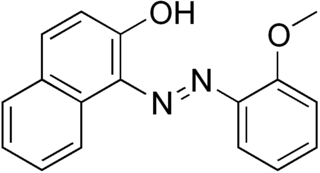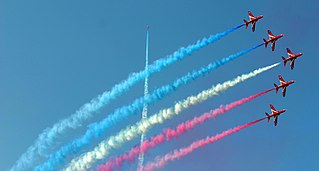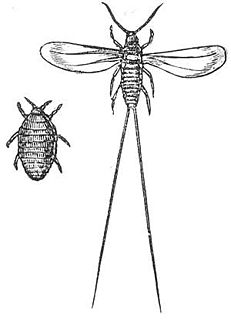
A dye is a colored substance that chemically bonds to the substrate to which it is being applied. This distinguishes dyes from pigments which do not chemically bind to the material they color. The dye is generally applied in an aqueous solution, and may require a mordant to improve the fastness of the dye on the fiber.

A kipper is a whole herring, a small, oily fish, that has been split in a butterfly fashion from tail to head along the dorsal ridge, gutted, salted or pickled, and cold-smoked over smouldering woodchips.

Magenta is a colour that is variously defined as purplish-red, reddish-purple or mauvish-crimson. On colour wheels of the RGB (additive) and CMY (subtractive) colour models, it is located exactly midway between red and blue; this makes magenta an "impossible color". It is one of the four colours of ink used in colour printing by an inkjet printer, along with yellow, black, and cyan, to make all other colours. The tone of magenta used in printing is called "printer's magenta".

Food coloring, or color additive, is any dye, pigment or substance that imparts color when it is added to food or drink. They come in many forms consisting of liquids, powders, gels, and pastes. Food coloring is used both in commercial food production and in domestic cooking. Food colorants are also used in a variety of non-food applications including cosmetics, pharmaceuticals, home craft projects, and medical devices.
Crimson is a strong, red color, inclining to purple. It originally meant the color of the kermes dye produced from a scale insect, Kermes vermilio, but the name is now sometimes also used as a generic term for slightly bluish-red colors that are between red and rose.

Dyeing is the application of dyes or pigments on textile materials such as fibers, yarns, and fabrics with the goal of achieving color with desired color fastness. Dyeing is normally done in a special solution containing dyes and particular chemical material. Dye molecules are fixed to the fiber by absorption, diffusion, or bonding with temperature and time being key controlling factors. The bond between dye molecule and fiber may be strong or weak, depending on the dye used. Dyeing and printing are different applications; in printing, color is applied to a localized area with desired patterns. In dyeing, it is applied to the entire textile.

Azo compounds are compounds bearing the functional group diazenyl R−N=N−R′, in which R and R′ can be either aryl or alkyl.

Methyl red, also called C.I. Acid Red 2, is an indicator dye that turns red in acidic solutions. It is an azo dye, and is a dark red crystalline powder. Methyl red is a pH indicator; it is red in pH under 4.4, yellow in pH over 6.2, and orange in between, with a pKa of 5.1. Murexide and methyl red are investigated as promising enhancers of sonochemical destruction of chlorinated hydrocarbon pollutants. Methyl red is classed by the IARC in group 3 - unclassified as to carcinogenic potential in humans.

Azo dyes are organic compounds bearing the functional group R−N=N−R′, in which R and R′ are usually aryl. They are a commercially important family of azo compounds, i.e. compounds containing the linkage C-N=N-C. Azo dyes are widely used to treat textiles, leather articles, and some foods. Chemically related to azo dyes are azo pigments, which are insoluble in water and other solvents.

Sudan Red G is a yellowish red lysochrome azo dye. It has the appearance of an odorless reddish-orange powder with melting point 225 °C. It is soluble in fats and used for coloring of fats, oils, and waxes, including the waxes used in turpentine-based polishes. It is also used in polystyrene, cellulose, and synthetic lacquers. It is insoluble in water. It is stable to temperatures of about 100–110 °C. It was formerly used as a food dye. It is used in some temporary tattoos, where it can cause contact dermatitis. It is also used in hair dyes. It is a component of some newer formulas for red smoke signals and smoke-screens, together with Disperse Red 11.

Colored smoke is a kind of smoke created by an aerosol of small particles of a suitable pigment or dye.

Disperse Red 9, or 1-(methylamino)anthraquinone, is a red dye derived from anthraquinone. Disperse Red 9 is used in some older red and violet-red colored smoke formulations. It is used in the M18 colored smoke grenade and also often in dye packs. Its smoke producing properties can be improved by coating the dye particles with an inert material, e.g. an epoxy resin.

A dye pack is a radio-controlled device used by banks to foil a bank robbery by causing stolen cash to be permanently marked with dye shortly after a robbery. They were invented in Georgia, United States, in 1965. In most cases, a dye pack is placed in a hollowed-out space within a stack of banknotes, usually $10 or $20 bills. This stack of bills looks and feels identical to a real one, but usually subtly marked in a way that is only privy to selected bank employees. The development of flexible dye packs makes it virtually impossible to detect by persons handling the stack.
Dylon International is a British brand of textile dyes and other household chemicals. It was founded in 1946 by the Mayborn Group. The Mayborn Group sold Dylon International to European homecare company Spotless Group in 2008. Spotless Group was acquired by Henkel in 2014 which is the current owner of Dylon.

The cochineal is a scale insect in the suborder Sternorrhyncha, from which the natural dye carmine is derived. A primarily sessile parasite native to tropical and subtropical South America through North America, this insect lives on cacti in the genus Opuntia, feeding on plant moisture and nutrients. The insects are found on the pads of prickly pear cacti, collected by brushing them off the plants, and dried.

Digital textile printing is described as any ink jet based method of printing colorants onto fabric. Most notably, digital textile printing is referred to when identifying either printing smaller designs onto garments and printing larger designs onto large format rolls of textile. The latter is a growing trend in visual communication, where advertisement and corporate branding is printed onto polyester media. Examples are: flags, banners, signs, retail graphics.

Natural dyes are dyes or colorants derived from plants, invertebrates, or minerals. The majority of natural dyes are vegetable dyes from plant sources—roots, berries, bark, leaves, and wood—and other biological sources such as fungi.
Disperse dye is a category of synthetic dye intended for polyester and related hydrophobic fibers. Disperse dyes are polar molecules containing anthraquinone or azo groups. It is estimated that 85% of disperse dyes are azos or anthraquinone dyes.

Disperse Yellow 26, or 4-chloro-2-nitrodiphenylamine, is a disperse dye. The dye is used in polyamide and vinegar fiber dyeing. Disperse Yellow 26 is produced by the condensation of aniline and 1,4-dichloro-2-nitrobenzene.

Disperse Red 60, or 1-amino-4-hydroxy-2-phenoxyanthraquinone, is a popular disperse dye of the anthraquinone family of dyes. It is a dark red solid that is insoluble in water but soluble in dichloromethane.

















